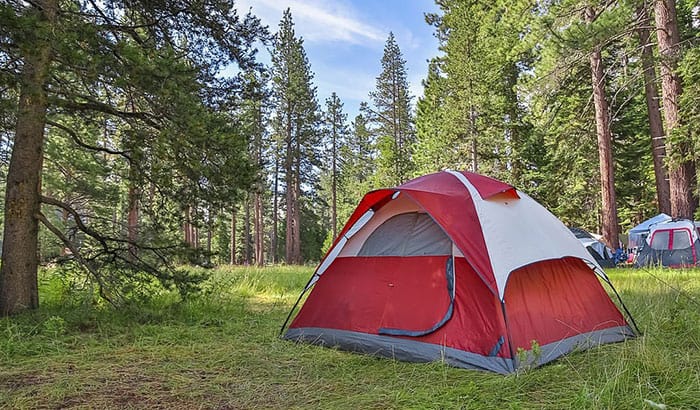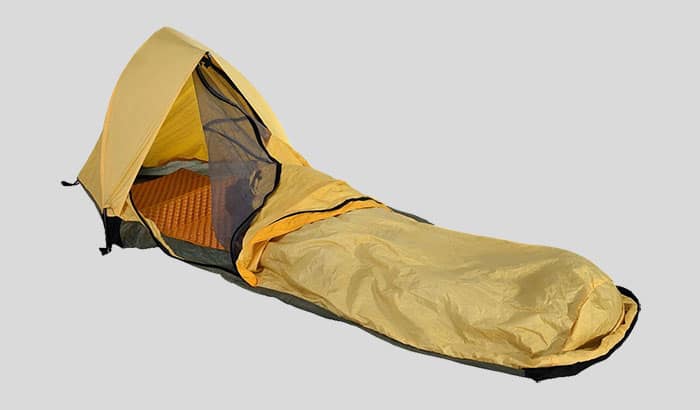When it comes to camping outside, the essential aspect to look up to is the shelter that will protect you during the night. There are two popular options to choose from for your shelter: bivy sack and tent.
But what are the differences between the two? A bivy sack is preferred mainly by backpackers or solo campers who want to travel light. As for the tent, we all know how it protects and provides shelter to the one using it, especially at night. This article will compare bivy sack vs tent and what it brings to the user when being used on the outside.
| Features | Bivy Sack | Tent |
| Weight | Lighter | Heavier |
| Space | Very Confined | Large Space |
| Packability and Setup | Quick and Easy | Takes Time |
| Security and Protection | Lesser Protection | Better Protection |
| Price | Affordable | Expensive |
Weight
When comparing a bivy sack and tent, the most essential feature to consider is its weight. The weight will be crucial because it affects the camper in terms of bringing all the essentials needed to the camp. Some people want to camp light, making them prefer lighter options.
In general, bivy sacks are more lightweight than tents, making them perfect for campers who do not want to bring more load into the camp. In fact, the traditional bivy sack only weighs between one or two pounds or less than one kilo.
On the other hand, the lightest single tent weighs around two and a half pounds, making it heavier than bivy sacks. But, light tents also mean they are not as durable as heavier tents because they only use delicate materials.
Space Availability
In this feature, the tent has the advantage. Whatever type of bivy sack you choose, its space will not be a match even with the smallest single-person tent available on the market. There is not enough space for bivy sacks because it is built that way.
In fact, bivy sacks only require the length and the width of a person’s sleeping system. But this lack of space also opens campsite possibilities under challenging locations such as rock ledges, snow caves, and narrow backcountry spaces.
On the other hand, those campers who prefer tents like more space for them to read, bath, and do other forms of activities that need privacy. The space will even give you the ability to eat inside the tent if you are not using a flame.
Because of the area, the tent will also allow a camper to get in or out quickly. The camper can quickly move with ease and reduces the feeling of claustrophobia. This feature is different when sleeping in a bivy sack which feels like sleeping in a body bag.
Packability and Setup
Other factors that can be considered to know the difference between a bivy sack and a tent is its ability to be packed easily and set up in the camp. With its compact size, the bivy sack makes it easy to pack or store before going to the camp.
The bivy sack is also easier to set up and probably the quickest. All you have to do is lay it on the ground, and you are good to go. On the other hand, setting up a tent can be challenging because you need to set up the poles, stakes, guy lines, and flysheet.
There is so much efficiency when you use bivy sacks. There is no setup nor pitching. There is also no hassle for the camper. After a long day of adventure, there is nothing to assemble from the sunset until the following day, which allows the camper to save time and energy for the next day.
Security and Protection
Another factor that you can use to compare bivvy and tent is their ability to give protection to the camper. I can say that the tent provides much better protection than the bivy sack because of how it is built.
Many elements will make you unsafe once you are in the wilderness, but the tent gives you much better protection from them. For example, if you are in a place known for bear attacks, the size of the tent will repel the bear from going near you.
Tents will also give much better protection from small creatures in the wild such as insects, mice, and even scorpions. For bivy sacks, the face is usually open and is vulnerable to possible attacks by these dangerous small creatures.
A tent will also give much better protection when it comes to the weather. It will protect you much better from a storm or keep you dry when it is raining. With bivy sacks, you are exposed and will not provide shelter from the rain.
Breathability and Ventilation
In this feature, the tent has a clear advantage because of the way it is constructed. There is enough space above your head to allow the air to circulate freely, giving you more ventilation while you are inside. The flysheet and the internal roof also come with vents that allow the air to circulate and provide proper ventilation.
On the other hand, bivy sacks are entirely the opposite, with no ventilation. Although there are the latest models with poles that allow you to give some sort of ventilation, even this is not comparable to the one being provided by a tent.
Cost
You can also tell the difference between the two by the amount of dollars you shell out from your wallet when purchasing one of them. Depending on the style, you can buy a decent tent for about $200. On the other hand, a decent bivy sack will only cost half or probably less.
Conclusion
Learning the difference between bivy sack vs tent is essential for you to know the better equipment in relation to your camping preference. If you like spacious and properly ventilated shelter, a tent is perfect. On the other hand, if you want a lighter and more affordable shelter, the bivy sack will fit your requirements.


